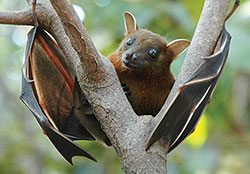Bats’ ears may solve an evolutionary puzzle
DOI: 10.1063/PT.3.3488
Despite the common saying, bats aren’t actually blind—but about 85% of bat species can hunt in the dark by tracking the echoes of their own voices, an ability called laryngeal echolocation. (See the article by Whit Au and Jim Simmons, Physics Today, September 2007, page 40

WIKIMEDIA COMMONS

A team of researchers led by Shuyi Zhang at Shenyang Agricultural University may have uncovered new clues to this evolutionary mystery by studying the fetal development of bats’ ears. Many animals exhibit vestigial structures inherited from distant ancestors during early stages of development. Human embryos, for example, begin with a tail.
Zhang’s team, along with Emma Teeling at University College Dublin, analyzed the development of the cochlea, a spiral-shaped bone in the inner ear. Species that use laryngeal echolocation have extremely large cochleae relative to their skull size; that trait enables greater sensitivity to the vibrations generated by their echoing voices.
The researchers tracked relative cochlear size at different stages of fetal development for seven species of bat and for five other mammals. They found that at early stages of fetal development, the relative cochlear size of the Old World fruit bats was similar to that of bat species capable of laryngeal echolocation. Whereas more-developed fruit bat fetuses had smaller cochleae than their laryngeal-echolocating relatives, they still had relatively large cochleae compared with other non-echolocating species such as mice and hedgehogs. The presence of large fetal cochleae suggests that Old World fruit bats did indeed descend from an ancestor capable of laryngeal echolocation. (Z. Wang et al., Nat. Ecol. Evol. 1, 0021, 2017, doi:10.1038/s41559-016-0021
